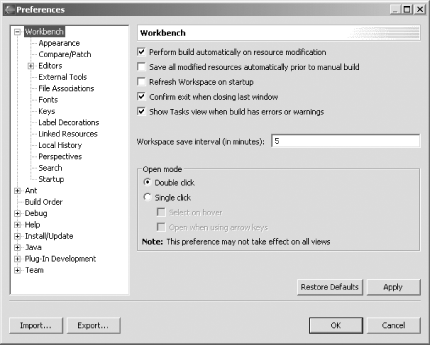| This chapter is about mastering Eclipse in everyday use. Chapter 1 gave you the basics; this chapter is designed to give you a working knowledge. As with any complex tool, you might want to change things about Eclipse as you work with it more and more. So, in addition to teaching you how to work with Eclipse, this chapter also teaches you the many ways in which you can customize Eclipse, from moving views to creating your own perspectives. When it comes to customizing Eclipse, one dialog stands out over the rest: the Preferences dialog, which you open by selecting Window  Preferences. This dialog is shown in Figure 2-1. Preferences. This dialog is shown in Figure 2-1. Figure 2-1. The Preferences dialog 
I encourage you to become familiar with this dialog. The Preferences dialog is the home of Eclipse customization, especially workbench customization. Want to automatically close all editors when you exit Eclipse (which enables Eclipse to start more quickly next time)? Select Window  Preferences Preferences  Workbench Workbench  Editors and then check the "Close all editors on exit" checkbox. Want to make editor tabs appear on the bottom of editor windows ? Select Window Editors and then check the "Close all editors on exit" checkbox. Want to make editor tabs appear on the bottom of editor windows ? Select Window  Preferences Preferences  Workbench Workbench  Appearance, and click Bottom in the Editor tab position box. Want to specify what editor or program Eclipse should use to open files with a certain file extension? Select Window Appearance, and click Bottom in the Editor tab position box. Want to specify what editor or program Eclipse should use to open files with a certain file extension? Select Window  Preferences Preferences  Workbench Workbench  File Associations, choose a file extension, and click the Add button. Problem solved . File Associations, choose a file extension, and click the Add button. Problem solved . But as powerful as the Preferences dialog is, it's just the beginning of the customization story. Eclipse can be customized in thousands of ways. Read on to get a grip on tailoring Eclipse to match your requirements. |  Preferences. This dialog is shown in Figure 2-1.
Preferences. This dialog is shown in Figure 2-1. 